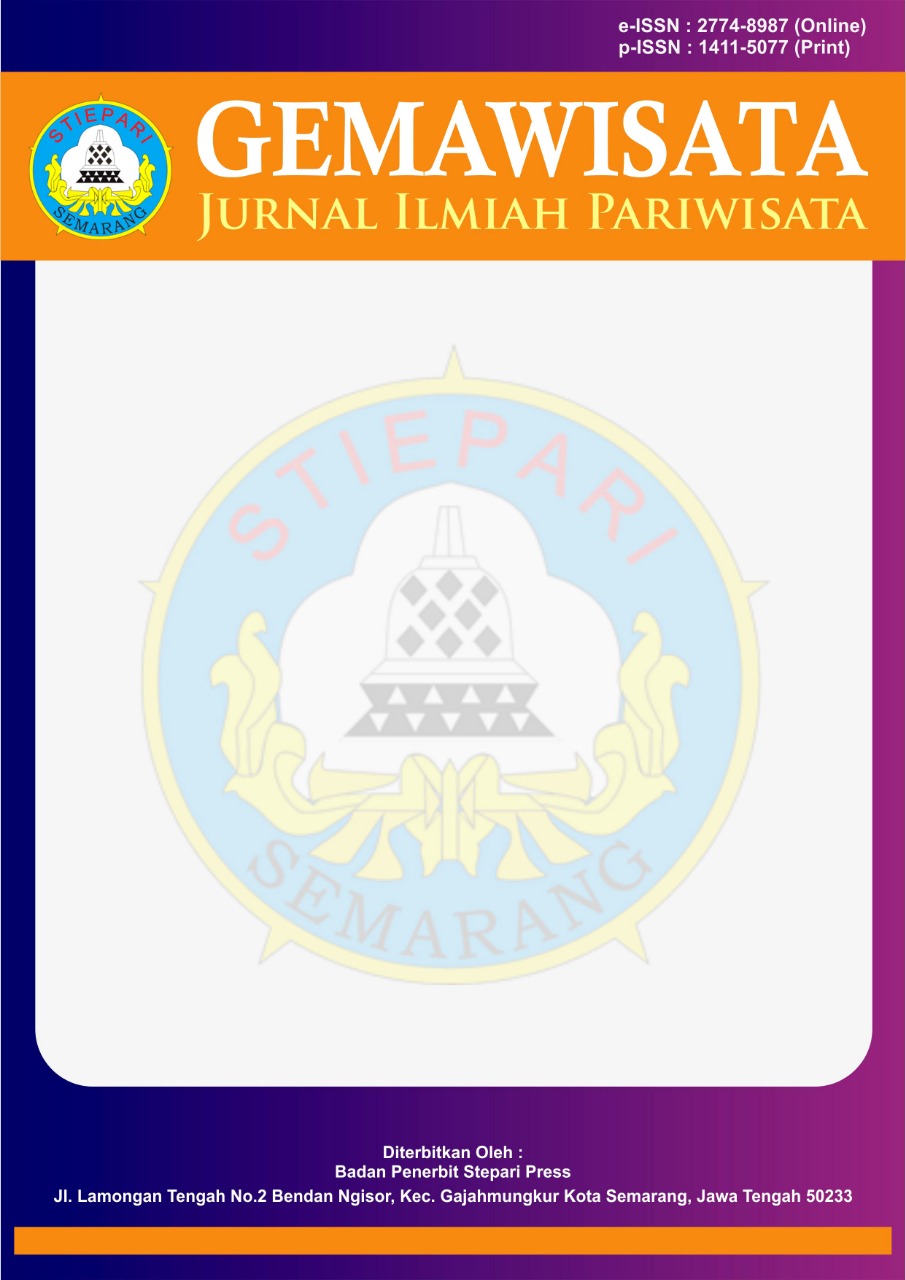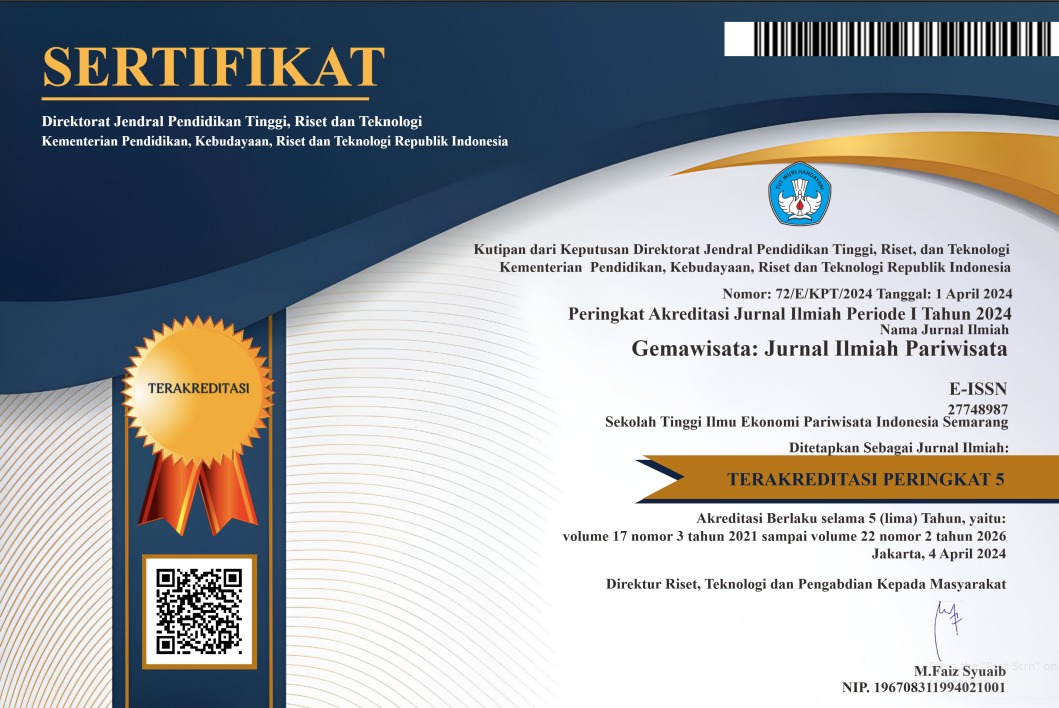Analisis Hubungan Pendirian Objek Wisata Menara Pandang terhadap Peningkatan Jumlah Kunjungan Wisatawan ke Objek Wisata Salib Kasih
DOI:
https://doi.org/10.56910/gemawisata.v21i3.859Keywords:
Establishment, Menara Pandang, Number of Visits, Relationship Analysis, Salib KasihAbstract
This study aims to analyze the relationship between the establishment of the Menara Pandang tourist attraction and the increase in the number of tourist visits to the Salib Kasih tourist destination. The research method used is qualitative with a descriptive approach. Data collection techniques were carried out through observation, interviews, and documentation with several informants, namely the Technical Implementation Unit (UPT) of Salib Kasih and Menara Pandang, the Tourism Office of North Tapanuli, tourism workers, local business actors, and visiting tourists. The results of the study show that the establishment of Menara Pandang has a significant relationship with the increase in tourist visits to Salib Kasih. This relationship can be seen from the growth in the number of tourists coming after the development of the new facility, namely Menara Pandang. Supporting factors of this relationship include the proximity of the two tourist sites, the development of integrated tour packages, active promotion through social media, and support from the local government in providing facilities and infrastructure. With this integration, tourists who previously only visited Salib Kasih are now encouraged to also enjoy the attraction of Menara Pandang, thus extending their length of stay and giving a positive impact on the local economy. Furthermore, this study also found that the existence of Menara Pandang strengthens the image of Salib Kasih as a religious tourism destination as well as natural tourism with its unique features and attractions. Therefore, the development of additional strategic tourist attractions can be an effective step in increasing both attractiveness and the number of tourist visits, especially in religious and nature-based destinations. This research emphasizes the importance of collaboration among stakeholders in sustainable tourism development.
References
Aninda, & Adriansyah. (2022). SINTAMA: Jurnal Sistem Informasi, Akuntansi dan Manajemen. SINTAMA: Jurnal Sistem Informasi, Akuntansi dan Manajemen, 2(3), 1–10. https://doi.org/10.54951/sintama.v2i3.390
Ariska, W. (2020). Analisis faktor tingkat kunjungan wisatawan pada kawasan objek wisata Candi Muara Takus (Skripsi, Universitas Islam Negeri Sultan Syarif Kasim Riau).
Husain Habibie, F. (n.d.). Pendidikan nasional pariwisata terhadap pengembangan dan tantangan dunia pariwisata.
Iqbal, M., Pradana, W., & Mahendra, G. K. (n.d.). Analisis dampak Covid-19 terhadap sektor pariwisata di objek wisata Goa Pindul Kabupaten Gunungkidul. JSPG: Journal of Social Politics and Governance.
Isdamarto. (2017). Dasar-dasar kepariwisataan dan pengelolaan destinasi pariwisata.
Iswadi, U., & Haerani, M. (2020). Analisa dan pengaruh metode hubungan industrial terhadap penyelesaian perselisihan di serikat pekerja sektoral Kota Cilegon tahun 2019. Ekono Insentif, 14(2), 91–100. https://doi.org/10.36787/jei.v14i2.291
Lengkong, C. M., Sengkey, R., & Sugiarso, A. (2019). Sistem informasi pariwisata berbasis web di Kabupaten Minahasa. Jurnal Teknik Informatika, 14(1), 1–10.
Maulini, U., & Andriyani, D. (n.d.). Aspek-aspek yang mempengaruhi jumlah kunjungan wisata Pantai Pangah Gandapura. Jurnal Ekonomi Regional. http://ojs.unimal.ac.id/index.php/ekonomi_regional
Nurrohman, F., Sahara, A., Iqbal, M., & Sanawiri, B. (2016). Analisis motivasi berkunjung wisatawan dan tingkat pengetahuan wisatawan tentang produk industri kreatif sektor kerajinan (Studi pada wisatawan domestik di Kota Batu, Jawa Timur). Jurnal Administrasi Bisnis, 35(2), 1–10.
Pomantow, C., Langi, F. M., & Waworuntu, C. N. (2022). Analisis perilaku wisatawan dalam memilih objek wisata di Kota Manado. Humanlight Journal of Psychology, 3(2), 102–113. http://ejournal-iakn-manado.ac.id/index.php/humanlight
Pusparini, L. P., Prayogi, P. A., & Mekarini, N. W. (2022). Pengaruh pengelolaan destinasi pariwisata terhadap kunjungan wisatawan. Journal of Tourism and Interdisciplinary Studies (JoTIS), 2(3), 1–11.
Suarnayasa, K., & Haris, I. A. (n.d.). Persepsi wisatawan terhadap keberadaan objek wisata air terjun di Dusun Jembong.
Suartini, N. K., Suhartawan, I. G., & Triawati, K. (2022). Manajemen pengelolaan objek wisata Taipa Beach. Jurnal Pariwisata PaRAMA: Panorama, Recreation, Accommodation, Merchandise, Accessibility, 3(1), 12–21. https://doi.org/10.36417/jpp.v3i1.456
Suwarti, S., Krisnawati, H., & Studi Pariwisata, P. (2019). Peningkatan jumlah kunjungan wisatawan sebagai daya tarik wisata Pantai Marina Semarang guna mendukung kesejahteraan masyarakat. E-Bisnis, 12(2), 43–49. https://doi.org/10.51903/e-bisnis.v12i2.489
Zulfirman, R. (2022). Implementasi metode outdoor learning dalam peningkatan hasil belajar siswa pada mata pelajaran Pendidikan Agama Islam di MAN 1 Medan. Jurnal Penelitian, Pendidikan dan Pengajaran, 3(2), 2022. https://doi.org/10.30596/jppp.v3i2.11758.


1_(1).jpg)






